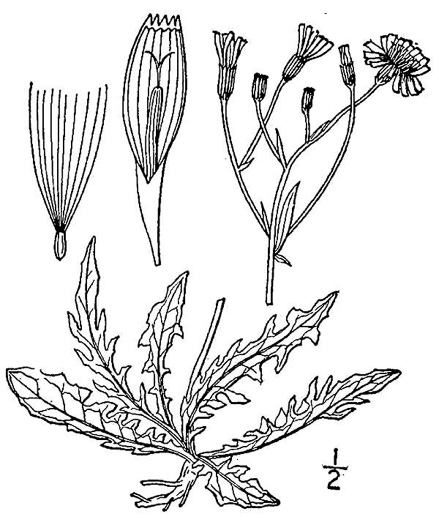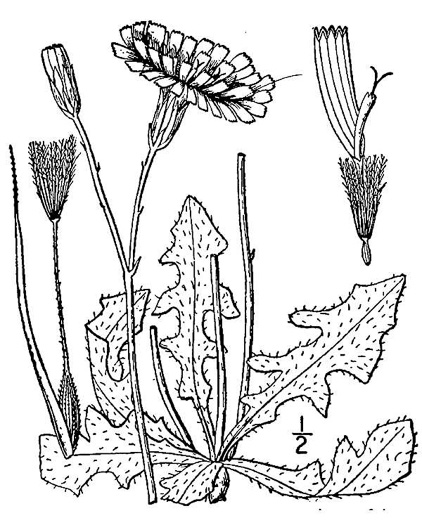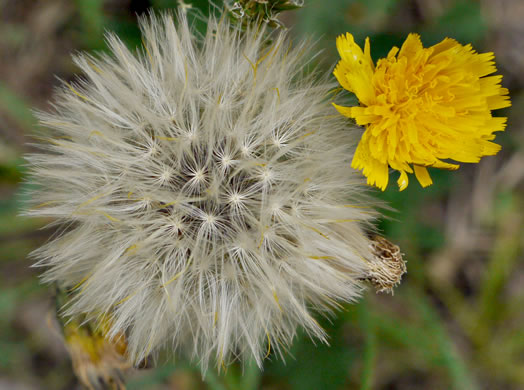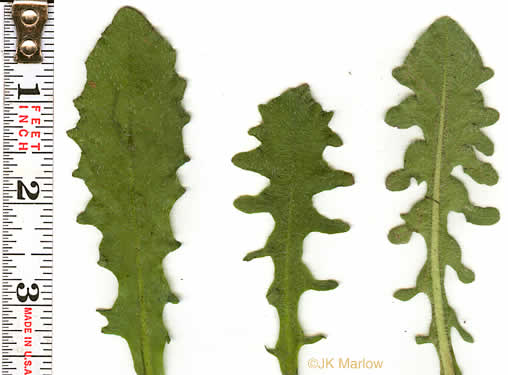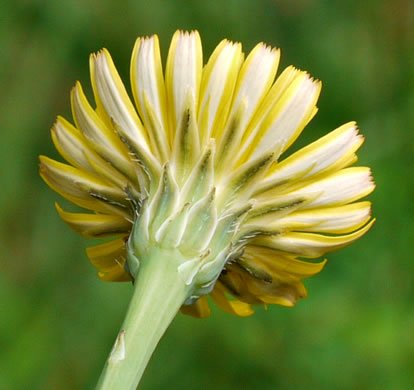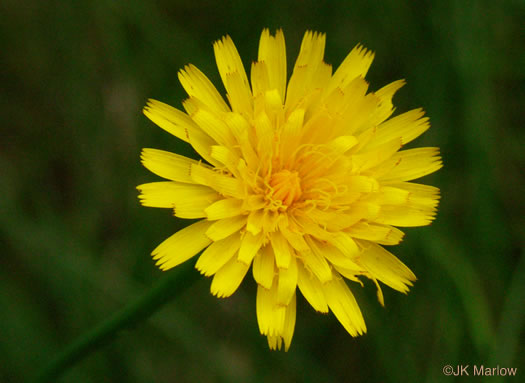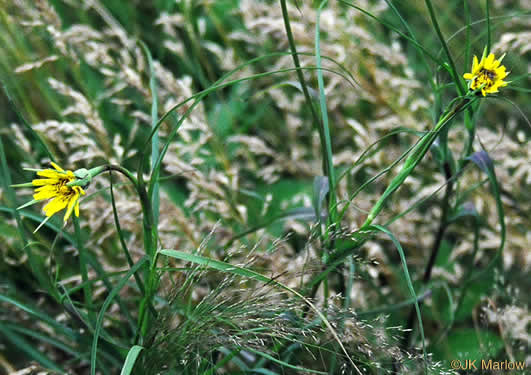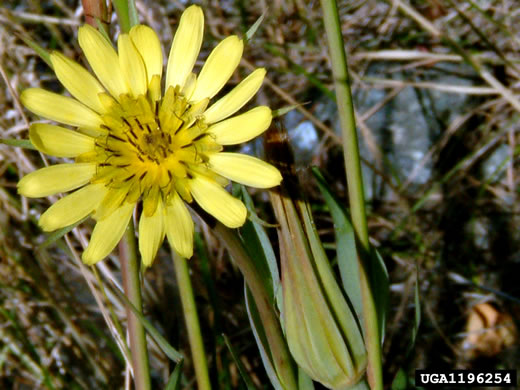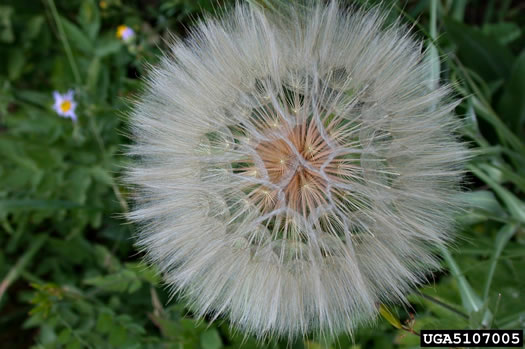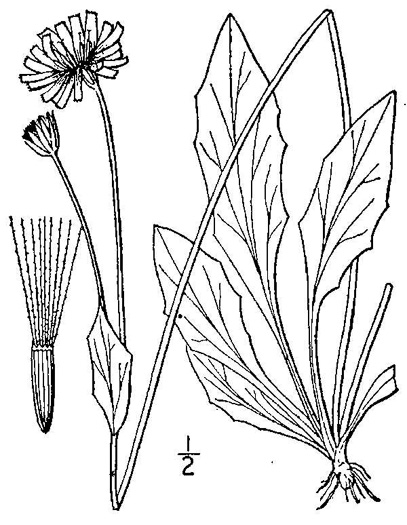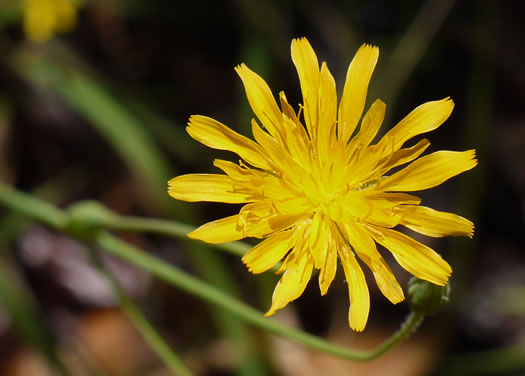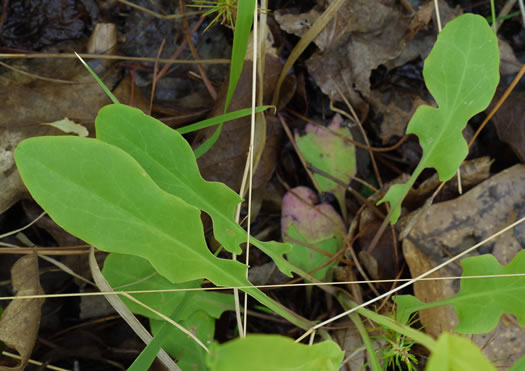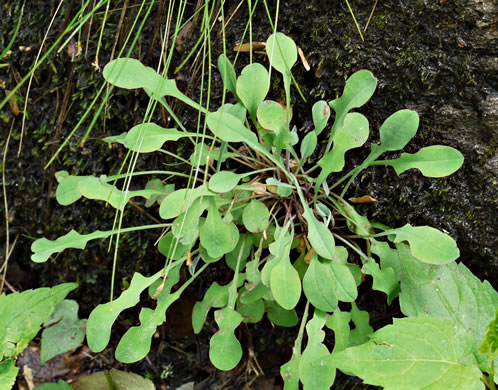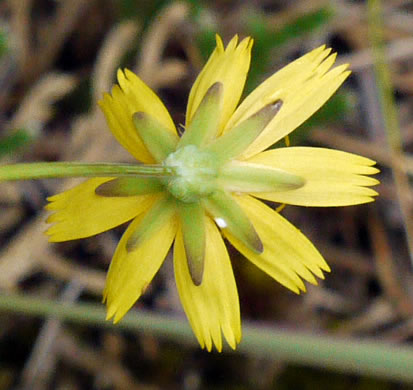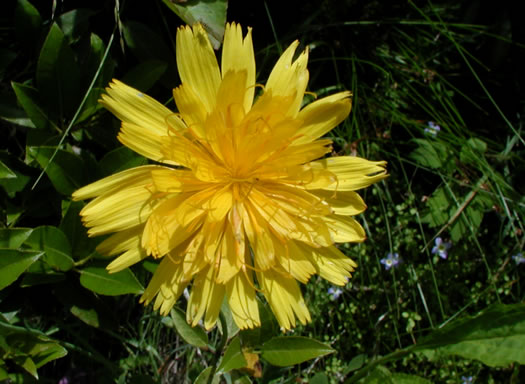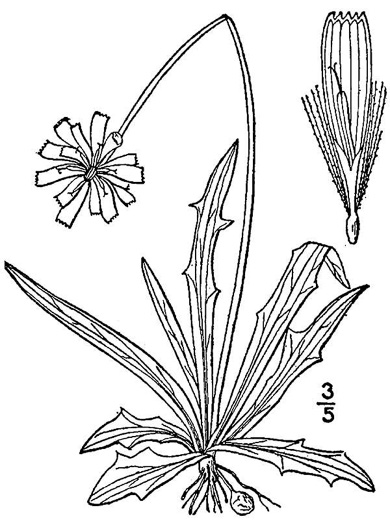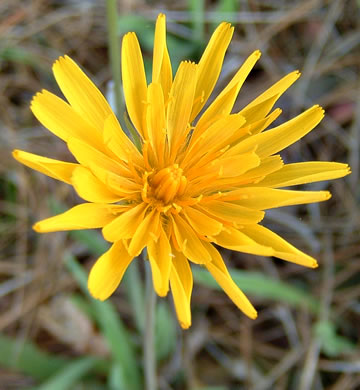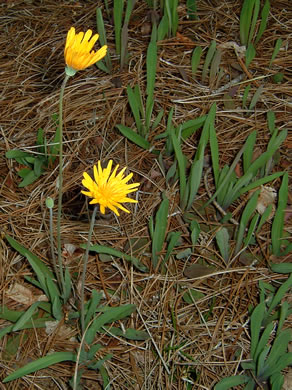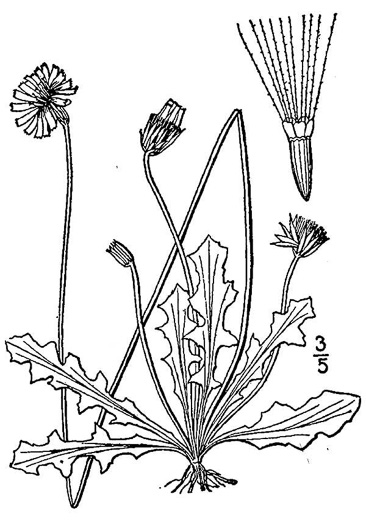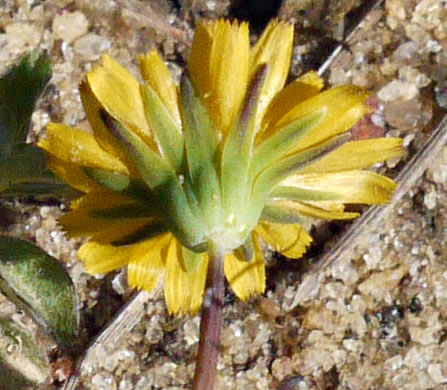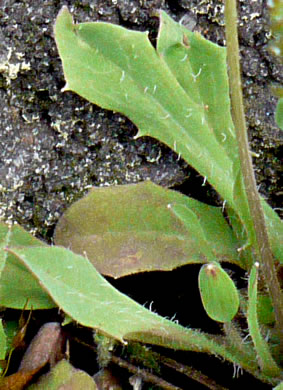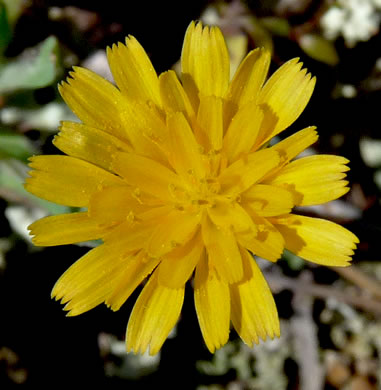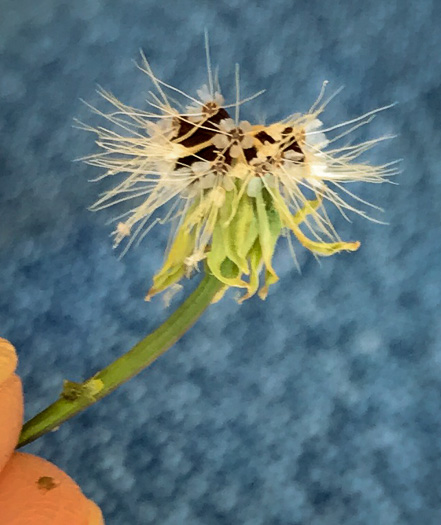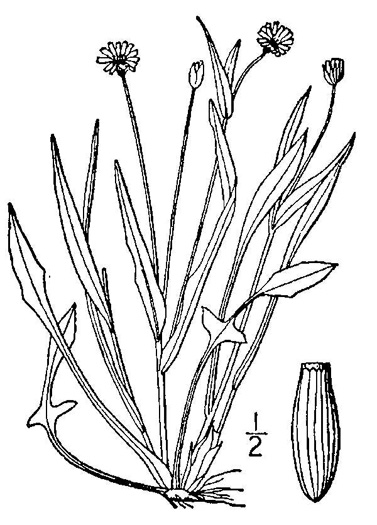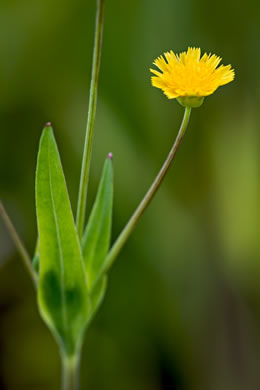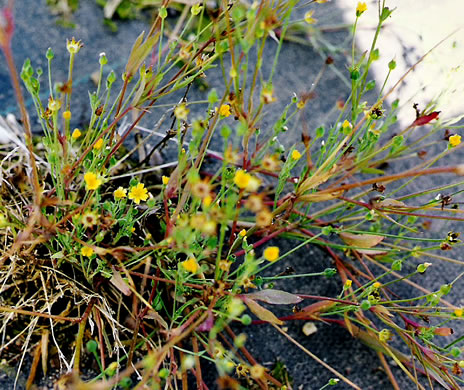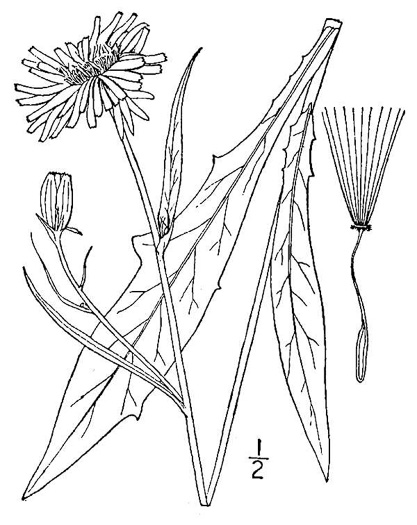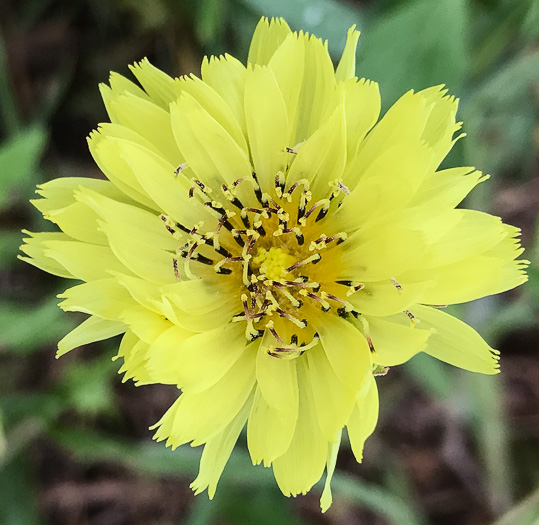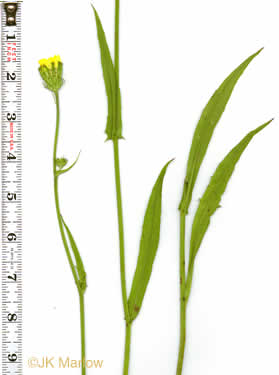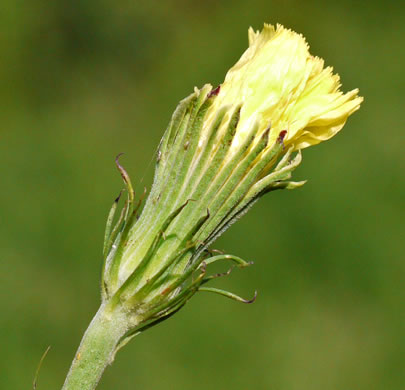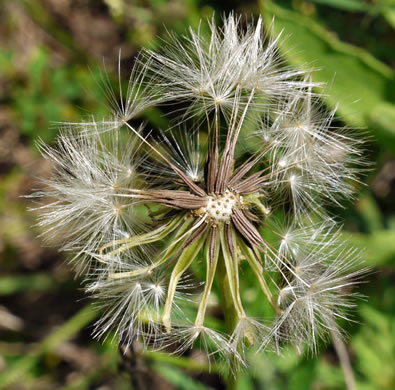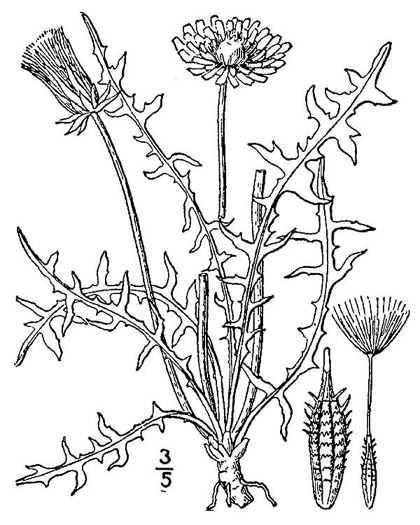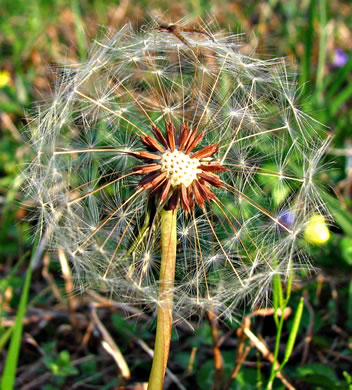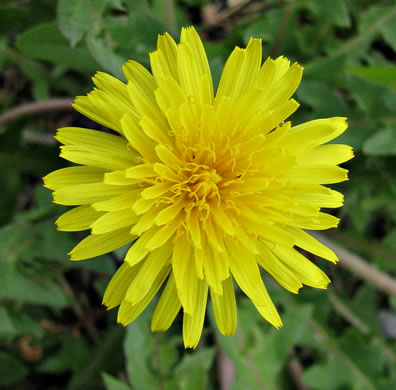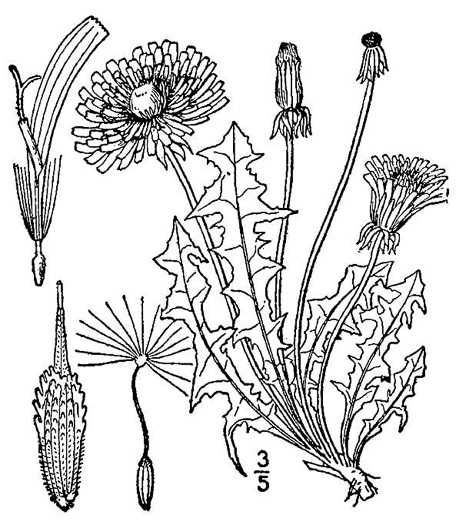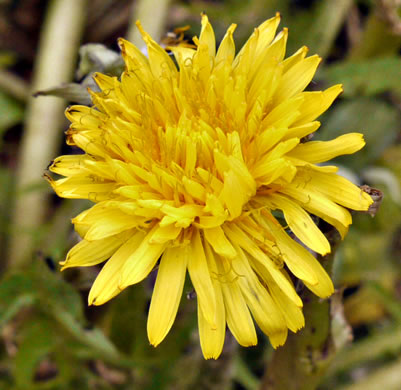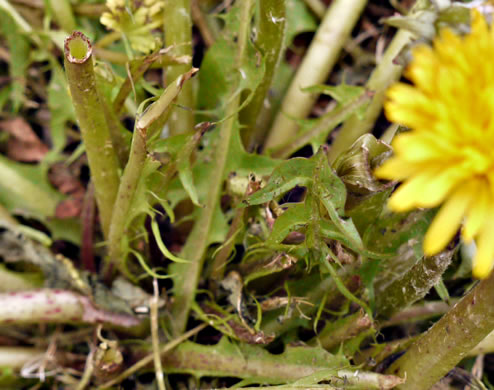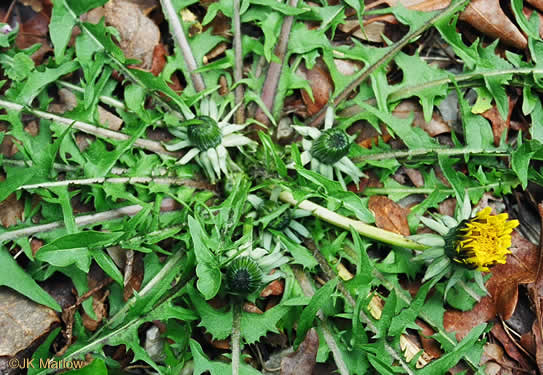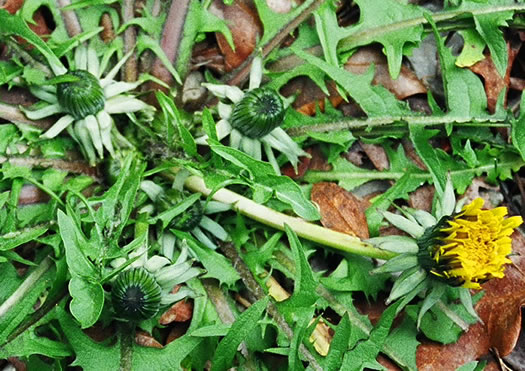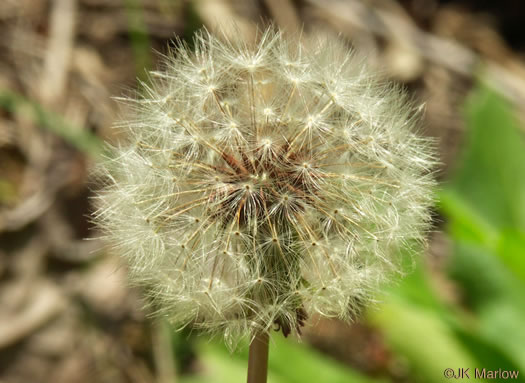Below are 41 plants that, like dandelions, are members of the Aster/Sunflower/Composite family and can have flower heads with yellow ray flowers and no disc flowers.
To see larger pictures, click or hover over the thumbnails.
To go to the plant's detail page, click its name.
 Habitat: Forests
Habitat: Forests
Involucre smooth with 7-9 principal bracts and 9-13 ray flowers per head, per Wildflowers of Tennessee, the Ohio Valley, and the Southern Appalachians (Horn, Cathcart, Hemmerly, & Duhl, 2005).
 Habitat: Mountain forests, grassy balds, at high elevations
Habitat: Mountain forests, grassy balds, at high elevations
Inflorescence cylindric, thyrsoid, the branches very short, per Weakley's Flora (2020).
The involucres have some long spreading hairs and black-tipped bracts, per Wildflowers of the Southern Mountains (Smith, 1998).
Leaves hastate [without additional lobes]; margins dentate, per Weakley's Flora (2020).
 Habitat: Mountain forests, grassy balds, at moderate to high elevations
Habitat: Mountain forests, grassy balds, at moderate to high elevations
 Habitat: Forests
Habitat: Forests
Petioles winged; leaf blades usually ovate or triangular, often deeply 3-lobed, per Flora of North America.
Usually 5 florets in each head, subtended by 5 smooth principal bracts, per Wildflowers of the Southern Mountains (Smith, 1998).
Cypselae subcylindric, subterete; pappi usually whitish or pale yellow, per Flora of North America.
 Habitat: Forests
Habitat: Forests
Inner bracts minutely bristly, outer narrowly lanceolate. Rays yellow-white, per Wildflowers of the Southern Mountains (Smith, 1998).
Involucre has 8 principal bracts w a few long coarse hairs, oft black-dotted, per Wildflowers of Tennessee (Carman, 2005).
Principal leaves usually evidently lobed, per Weakley's Flora (2023).
 Habitat: Roadsides, disturbed ground, pastures
Habitat: Roadsides, disturbed ground, pastures
Mostly smooth-stemmed with copious fine prickles on leaf margins and midrib, per Wildflowers of the Southern Mountains (Smith, 1998).
Involucres 10-15mm long, 3-5mm broad. Bracts imbricate, per Vascular Flora of the Carolinas (Radford, Ahles, & Bell, 1968).
Heads are ligulate (having only ray flowers), small, and yellow-flowered, per Wildflowers of the Southern Mountains (Smith, 1998).
Nutlets brown, oblanceolate, 5-ribbed on each face; pappus white, per Vascular Flora of the Carolinas (Radford, Ahles, & Bell, 1968).
 Habitat: Fields, roadsides, disturbed ground, perhaps associated with circumneutral soils
Habitat: Fields, roadsides, disturbed ground, perhaps associated with circumneutral soils
 Habitat: Fields, roadsides, disturbed ground
Habitat: Fields, roadsides, disturbed ground
Orange-yellow flowers extend slightly from urn-shaped involucral cylinders, per Forest Plants of the Southeast and Their Wildlife Uses (Miller & Miller, 2005).
A smooth sometimes glaucous plant. Leaves variable but without spiny margins, per Wildflowers of the Southern Mountains (Smith, 1998).
Cypselae brown, ± flattened, elliptic, beaks ± filiform; pappi white, per Flora of North America.
Many pale to deep yellow flowers in each head, but involucres < 1/2" high, per Wildflowers of the Southern Mountains (Smith, 1998).
 Habitat: Dry, sandy or rocky woodlands, forest edges
Habitat: Dry, sandy or rocky woodlands, forest edges
Inflorescence with branches widely spreading (almost perpendicular) from the stem, per Weakley's Flora (2024).
Fruiting involucres 15-22mm tall (vs. those of L. canadensis 10-15mm tall), per Weakley's Flora (2020).
Flowers heads relatively large, the involucres measuring 1/2"+ in height, per Wildflowers of the Southern Mountains (Smith, 1998).
Lobes blocky, widest above the base and blunt, square or rounded at the tip (like a Post Oak), per Weakley's Flora (2023).
 Habitat: Pastures, roadsides, forest edges, thickets
Habitat: Pastures, roadsides, forest edges, thickets
Stem usually green and leafy. Leaf bases clasping to slightly auriculate, per Vascular Flora of the Carolinas (Radford, Ahles, & Bell, 1968).
Flowers typically blue, but yellow in one form. Panicle branches short and ascending, per Wildflowers of the Southern Mountains (Smith, 1998).
Leaves on winged petioles, 4-12" long, with several wide, coarsely toothed, pointy-tipped lobes, per Wildflowers of the Atlantic Southeast (Cotterman, Waitt, & Weakley, 2019).
Panicle branches short and ascending (vs. those of L. floridana long and spreading), per Wildflowers of the Southern Mountains (Smith, 1998).
 Habitat: Cultivated throughout our area in home gardens and commercially, rarely weakly persistent, common as a cultivated plant, rare as a short-lived waif
Habitat: Cultivated throughout our area in home gardens and commercially, rarely weakly persistent, common as a cultivated plant, rare as a short-lived waif
 Habitat: Disturbed areas
Habitat: Disturbed areas
Heads 30-50mm across in flower. Phyllaries and peduncles glabrous, per Weakley's Flora (2015).
 Habitat: Roadsides, fields, pastures, disturbed areas
Habitat: Roadsides, fields, pastures, disturbed areas
Involucres 10-13mm long, 8-14mm broad, bracts lanceolate, per Vascular Flora of the Carolinas (Radford, Ahles, & Bell, 1968).
Rays light yellow, 1.5-2.5cm long, per Vascular Flora of the Carolinas (Radford, Ahles, & Bell, 1968).
Rounded ear-like projections at leaf bases clasping the stem, per Forest Plants of the Southeast and Their Wildlife Uses (Miller & Miller, 2005).
 Habitat: Roadsides, fields, pastures, disturbed areas
Habitat: Roadsides, fields, pastures, disturbed areas
Most leaves conspicuously sagittate-clasping with pointed basal lobes, per Wildflowers of the Southern Mountains (Smith, 1998).
Flower heads average about 3/4" across, per Wildflowers of the Southern Mountains (Smith, 1998).
Involucres 8-13mm long, 6-14mm broad; bracts rarely glandular, per Vascular Flora of the Carolinas (Radford, Ahles, & Bell, 1968).
Pappus bristles white, capillary, per Vascular Flora of the Carolinas (Radford, Ahles, & Bell, 1968).
 Habitat: Disturbed areas
Habitat: Disturbed areas
 Habitat: Pastures, roadsides, disturbed areas
Habitat: Pastures, roadsides, disturbed areas
Involucres 7-12mm long, clothed with black trichomes and stipitate glands, per Vascular Flora of the Carolinas (Radford, Ahles, & Bell, 1968).
Nutlets lustrous black, columnar, 2-2.3mm long; pappus 4-6mm long, per Vascular Flora of the Carolinas (Radford, Ahles, & Bell, 1968).
Leaves oblanceolate to elliptic-oblanceolate, leaf base cuneate to attenuate, per Vascular Flora of the Carolinas (Radford, Ahles, & Bell, 1968).
Rays light yellow and 5-toothed, per Vascular Flora of the Carolinas (Radford, Ahles, & Bell, 1968).
 Habitat: Roadsides
Habitat: Roadsides
Plants stoloniferous, per Weakley's Flora (2022).
Leaves nearly glabrous on the upper surface, per Weakley's Flora (2022).
Heads 2-4+ in ± umbelliform to corymbiform arrays. Corollas yellow, per Flora of North America.
 Habitat: Pastures, fields, roadsides, grassy balds
Habitat: Pastures, fields, roadsides, grassy balds
There are several heads in a compact inflorescence, per Wildflowers of the Southern Mountains (Smith, 1998).
Leaves densely & softly hairy on both sides, oblanceolate to elliptic, per Wildflowers of Tennessee, the Ohio Valley, and the Southern Appalachians (Horn, Cathcart, Hemmerly, & Duhl, 2005).
Stem & involucres have conspicuous black-tipped glandular hairs, per Wildflowers of the Southern Mountains (Smith, 1998).
 Habitat: Fields, pastures, roadsides
Habitat: Fields, pastures, roadsides
 Habitat: Dry forests, woodland margins, roadsides
Habitat: Dry forests, woodland margins, roadsides
Rays golden-yellow, 5-toothed, per Vascular Flora of the Carolinas (Radford, Ahles, & Bell, 1968).
Peduncles usually stipitate-glandular. Bracts acute, about 1mm wide, per Vascular Flora of the Carolinas (Radford, Ahles, & Bell, 1968).
Leaves conspicuously purple-veined, mostly smooth or with hairy margins, per Wildflowers of Tennessee, the Ohio Valley, and the Southern Appalachians (Horn, Cathcart, Hemmerly, & Duhl, 2005).
Nutlets lustrous black, columnar, slightly tapered apically. Pappus yellowish, per Vascular Flora of the Carolinas (Radford, Ahles, & Bell, 1968).
 Habitat: Dry to mesic forests, especially along dirt roads
Habitat: Dry to mesic forests, especially along dirt roads
Leaves elliptic, base cuneate to attenuate. Basal leaves few or absent, per Vascular Flora of the Carolinas (Radford, Ahles, & Bell, 1968).
The flowers heads are small (1/2" wide or less), per Wildflowers of the Southern Mountains (Smith, 1998).
Pappus yellowish to tan, 3-4mm long, per Vascular Flora of the Carolinas (Radford, Ahles, & Bell, 1968).
 Habitat: Dry forests, woodland margins, roadsides
Habitat: Dry forests, woodland margins, roadsides
Blooms in late spring-summer; except for H. venosum, our other Hieraciums don't begin till July, per Vascular Plants of North Carolina.
Lower stem strongly pilose; leaves weakly purple-veined, primarily basal, per Weakley's Flora (2025).
Involucre glabrous or w short stipitate glands, but lacking long setae [bristles], per Weakley's Flora (2025).
Considered to derive from hybridization between H. gronovii and H. venosum, per Weakley's Flora (2025).
 Habitat: Longleaf pine sandhills, dry forests and woodlands, woodland margins, roadsides
Habitat: Longleaf pine sandhills, dry forests and woodlands, woodland margins, roadsides
Involucres 6-8mm long, 3-5mm broad, usually stipitate-glandular, per Vascular Flora of the Carolinas (Radford, Ahles, & Bell, 1968).
Hieracium has only ray flowers (no disk flowers), and the rays are 5-toothed, per Vascular Flora of the Carolinas (Radford, Ahles, & Bell, 1968).
Leaves oblanceolate to elliptic, long pilose, per Vascular Flora of the Carolinas (Radford, Ahles, & Bell, 1968).
Nutlets fusiform. Pappus tan, 4-6mm long, per Vascular Flora of the Carolinas (Radford, Ahles, & Bell, 1968).
 Habitat: Dry forests, woodland margins, roadsides
Habitat: Dry forests, woodland margins, roadsides
 Habitat: Flowerbeds, suburban woodlands, roadsides, disturbed areas, trail edges, hammocks, rocky woodlands, floodplains
Habitat: Flowerbeds, suburban woodlands, roadsides, disturbed areas, trail edges, hammocks, rocky woodlands, floodplains
Basal leaves oblanceolate, pinnatisect to runcinate [as in Taraxacum], per Vascular Flora of the Carolinas (Radford, Ahles, & Bell, 1968).
Involucre 3-5mm high (vs. Crepis 5-12mm high), per Weakley's Flora (2023).
Flower heads are small and composed of 10-20 ray flowers, per Atlantic Coastal Plain Wildflowers (Nelson, 2006).
 Habitat: Roadsides, fields, other disturbed places
Habitat: Roadsides, fields, other disturbed places
 Habitat: Roadsides, fields, disturbed areas
Habitat: Roadsides, fields, disturbed areas
Nutlets all beaked, often glaucous; pappus pale tan, 8-10mm long, per Vascular Flora of the Carolinas (Radford, Ahles, & Bell, 1968).
Leaves are basal, oblanceolate, and toothed or pinnatifid, per Wildflowers of Tennessee (Carman, 2005).
Involucral bracts imbricate, in several series, per Vascular Flora of the Carolinas (Radford, Ahles, & Bell, 1968).
Ray flowers yellow and numerous; disk flowers absent, per Wildflowers of Tennessee (Carman, 2005).
 Habitat: Roadsides, fields, disturbed areas
Habitat: Roadsides, fields, disturbed areas
 Habitat: Roadsides, fields, other disturbed places
Habitat: Roadsides, fields, other disturbed places
Rays pale yellow, obviously shorter than the longest phyllaries, per Weakley's Flora.
Ray flowers pale yellow; heads solitary on erect stalks, per Wildflowers of Tennessee, the Ohio Valley, and the Southern Appalachians (Horn, Cathcart, Hemmerly, & Duhl, 2005).
Pappus dingy white, per Weakley's Flora (2012).
 Habitat: Rich, moist forests
Habitat: Rich, moist forests
Ray flowers orangish-yellow and numerous. Disk flowers absent, per Wildflowers of Tennessee, the Ohio Valley, and the Southern Appalachians (Horn, Cathcart, Hemmerly, & Duhl, 2005).
Basal leaves either entire or with teeth or lobes near the tapered base, per Wildflowers of the Southern Mountains (Smith, 1998).
 Habitat: Cliffs and rock outcrops at medium to high elevations
Habitat: Cliffs and rock outcrops at medium to high elevations
Leaves mostly basal, wider leaves sometimes coarsely pinnate-dentate near base, per Vascular Flora of the Carolinas (Radford, Ahles, & Bell, 1968).
In Krigia, the involucral bracts are in 1 series, per Vascular Flora of the Carolinas (Radford, Ahles, & Bell, 1968).
Flower heads bright yellow, solitary on leafless stalk (disc flowers absent), per Wildflowers of the Southern Mountains (Smith, 1998).
 Habitat: Woodlands, roadsides, wet prairies, low damp meadows, disturbed areas
Habitat: Woodlands, roadsides, wet prairies, low damp meadows, disturbed areas
The 4-20" tall scape has a terminal, solitary flower head 1.2 to 1.8" wide, per Wildflowers of Tennessee (Carman, 2005).
Leaves smooth, glaucous, with tapering bases, per Wildflowers of Tennessee, the Ohio Valley, and the Southern Appalachians (Horn, Cathcart, Hemmerly, & Duhl, 2005).
 Habitat: Rocky woodlands, roadsides, disturbed areas
Habitat: Rocky woodlands, roadsides, disturbed areas
Krigia's involucral bracts are in a single series (vs. 2 in Taraxacum), per Wildflowers of the Southern Mountains (Smith, 1998).
Leaf faces glabrous, eglandular or loosely glandular-villous, per Flora of North America.
Flower heads 1-2" wide, solitary, consisting of ray flowers only, per Wildflowers of Tennessee, the Ohio Valley, and the Southern Appalachians (Horn, Cathcart, Hemmerly, & Duhl, 2005).
Pappus of 5 scales and 5 bristles, per Weakley's Flora (2022).
 Habitat: Fields, roadsides, disturbed places
Habitat: Fields, roadsides, disturbed places
Compact flower heads are borne singly at the end of short axillary stalks, per Atlantic Coastal Plain Wildflowers (Nelson, 2006).
The only leafy-branched Krigia of the southeastern Atlantic Coastal Plain, per Atlantic Coastal Plain Wildflowers (Nelson, 2006).
 Habitat: Dry and moist forests, roadsides, meadows, fields
Habitat: Dry and moist forests, roadsides, meadows, fields
Ray flowers pale yellow, numerous; disk flowers absent, per Wildflowers of Tennessee, the Ohio Valley, and the Southern Appalachians (Horn, Cathcart, Hemmerly, & Duhl, 2005).
Lvs oblanceolate to lanceolate, entire to deeply dissected, whitish midvein, per Forest Plants of the Southeast and Their Wildlife Uses (Miller & Miller, 2005).
Inner bracts in 1 series, outer bracts shorter & in several series, per Vascular Flora of the Carolinas (Radford, Ahles, & Bell, 1968).
Nutlets cylindric, tapered to both ends, 5-grooved, pubescent, per Vascular Flora of the Carolinas (Radford, Ahles, & Bell, 1968).
 Habitat: Roadsides, lawns, pastures, other disturbed sites
Habitat: Roadsides, lawns, pastures, other disturbed sites
Nutlets reddish-brown, per Vascular Flora of the Carolinas (Radford, Ahles, & Bell, 1968).
Disc flowers absent. Ray flowers yellow and bisexual, per Vascular Flora of the Carolinas (Radford, Ahles, & Bell, 1968).
 Habitat: Lawns, roadsides, urban areas, pastures, disturbed areas, trailsides, less commonly in a variety of less disturbed habitats
Habitat: Lawns, roadsides, urban areas, pastures, disturbed areas, trailsides, less commonly in a variety of less disturbed habitats
Disc flowers absent. Ray flowers yellow and bisexual, per Vascular Flora of the Carolinas (Radford, Ahles, & Bell, 1968).
Each scape is hollow and bears a single flower head, per Wildflowers of the Southern Mountains (Smith, 1998).
Leaves numerous in a basal rosette, deeply pinnatisect to barely lobed, per Vascular Flora of the Carolinas (Radford, Ahles, & Bell, 1968).
Outer involucral bracts are reflexed and about as long as inner bracts, per Wildflowers of Tennessee (Carman, 2005).
Fruits olive-brown achenes, pappus a tuft of white hairlike bristles, per Wildflowers of Tennessee, the Ohio Valley, and the Southern Appalachians (Horn, Cathcart, Hemmerly, & Duhl, 2005).

 Habitat: Fields, forests, vacant lots, disturbed areas
Habitat: Fields, forests, vacant lots, disturbed areas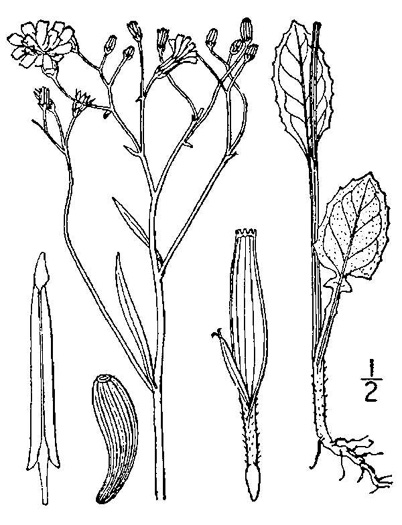
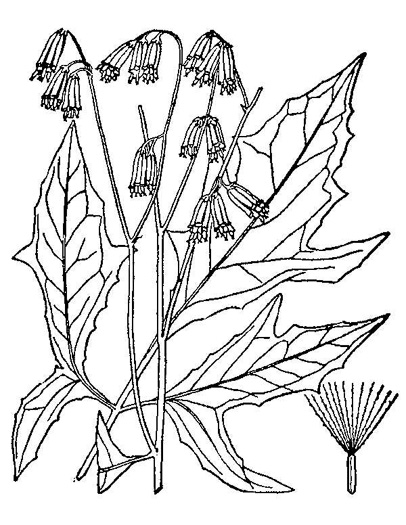
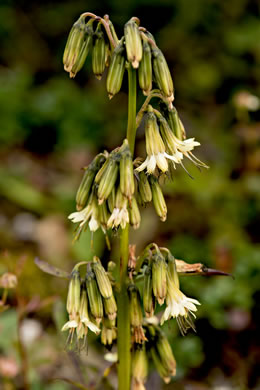
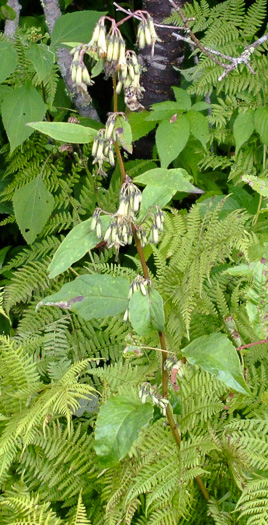
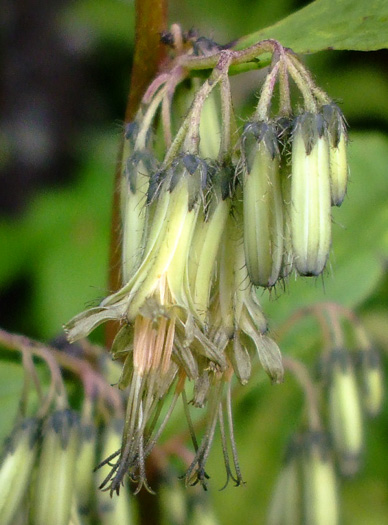
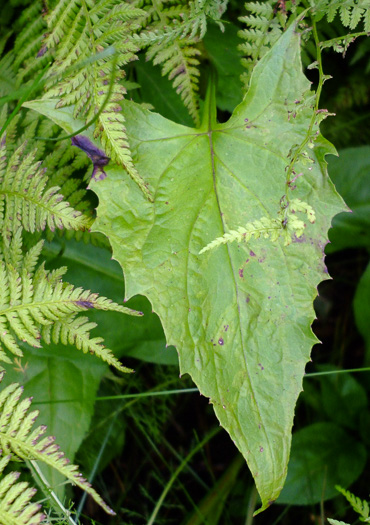
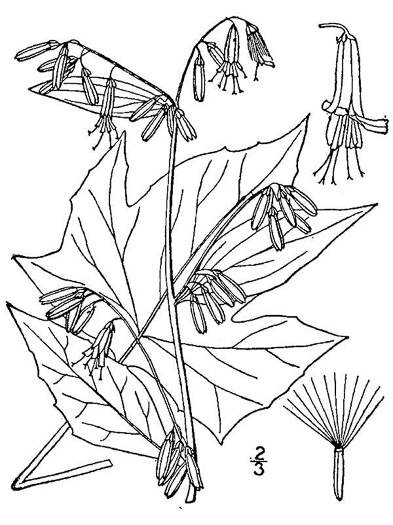
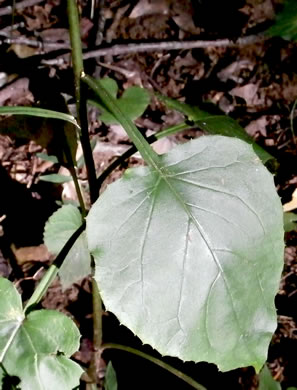
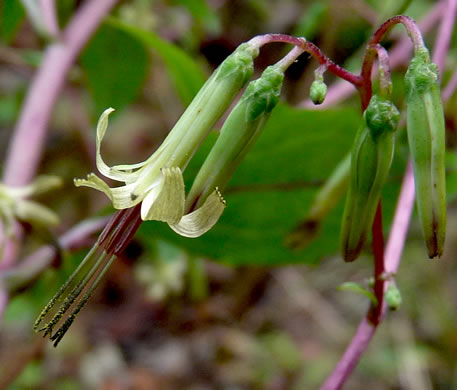
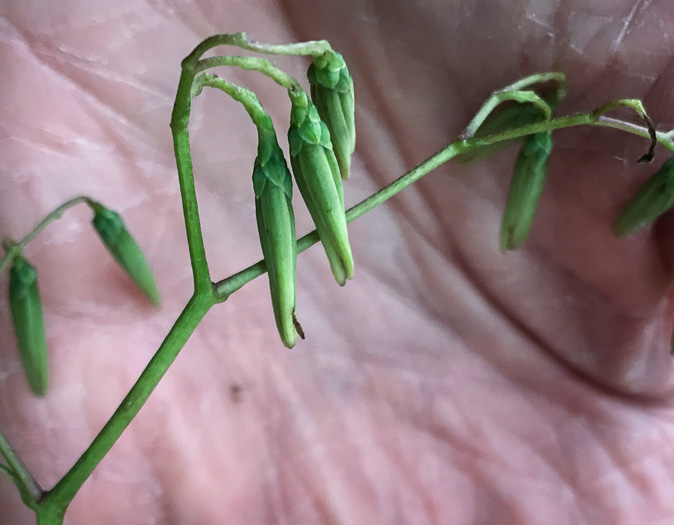
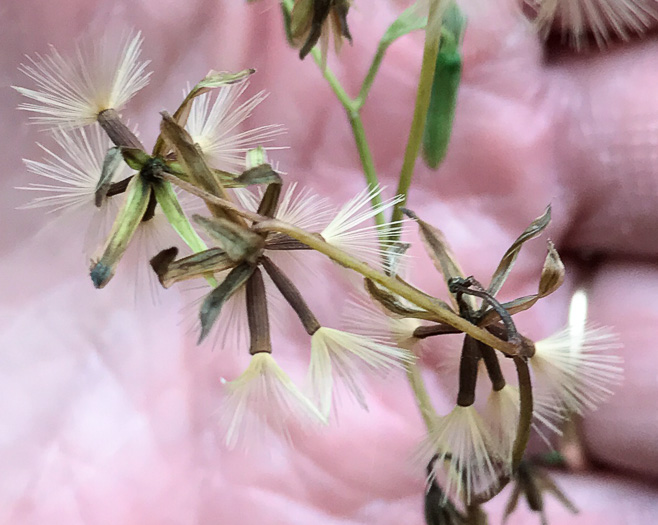
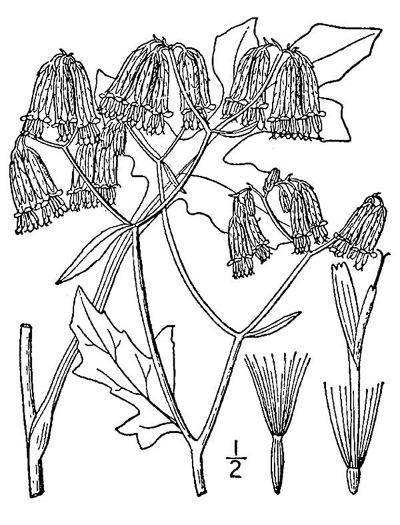
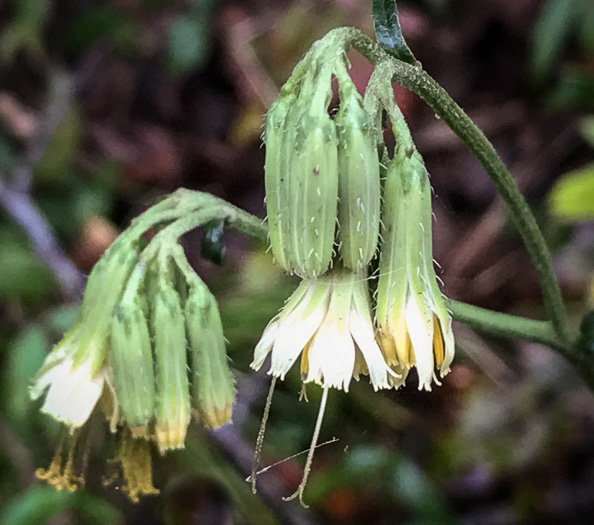
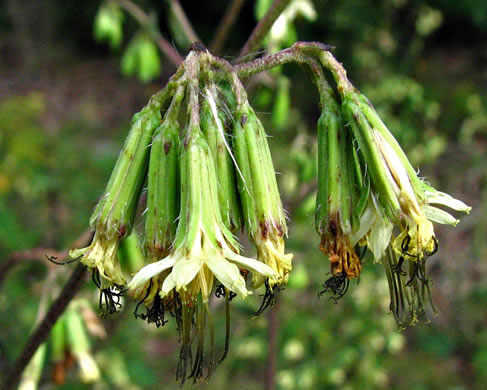
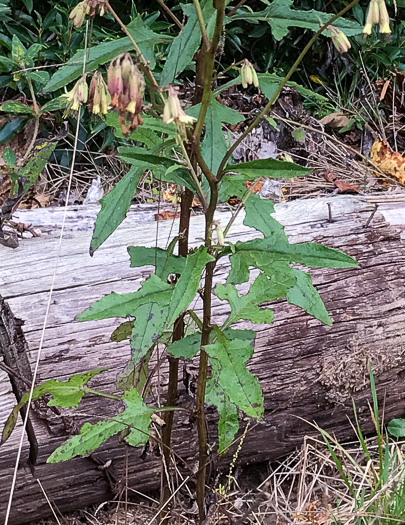
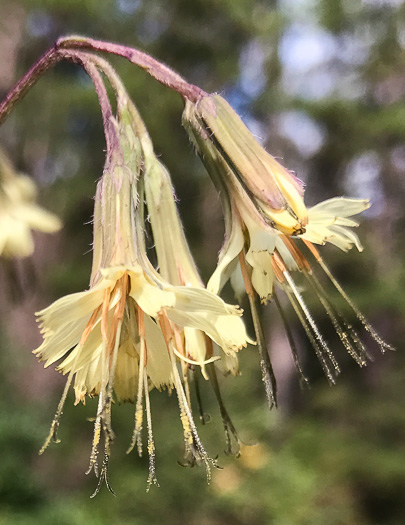
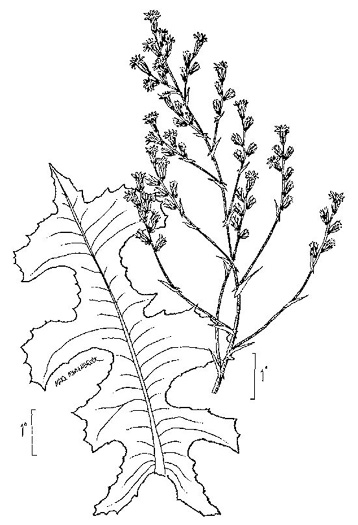
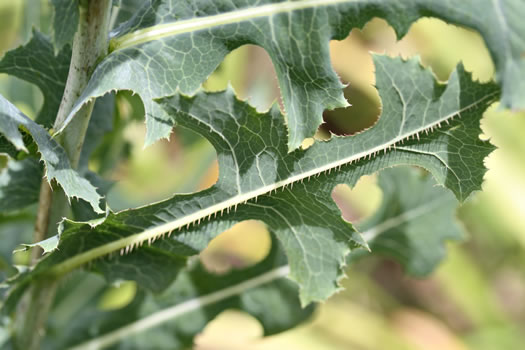
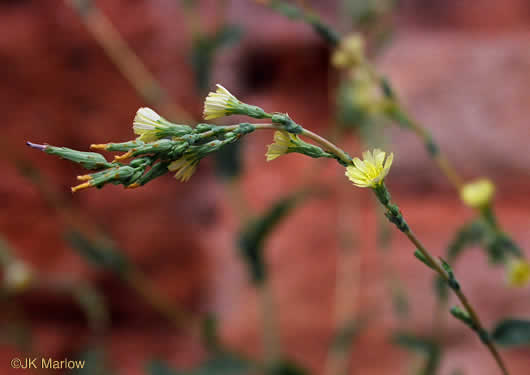
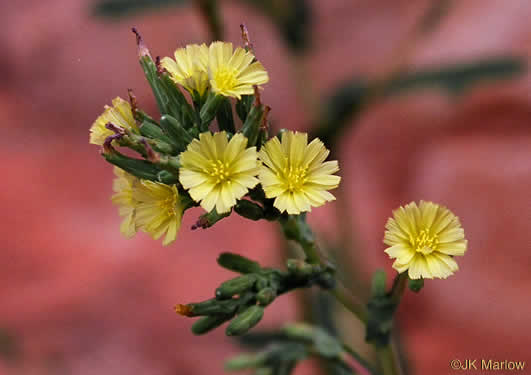
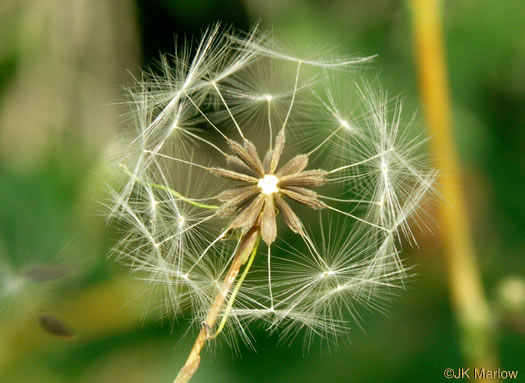
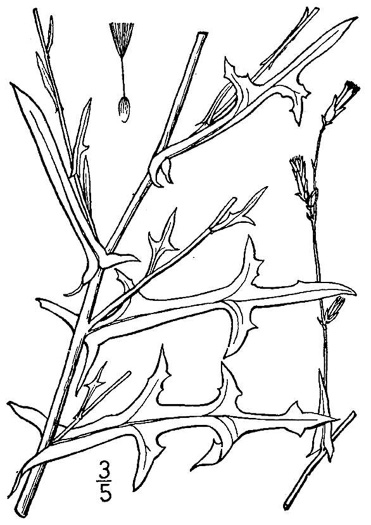
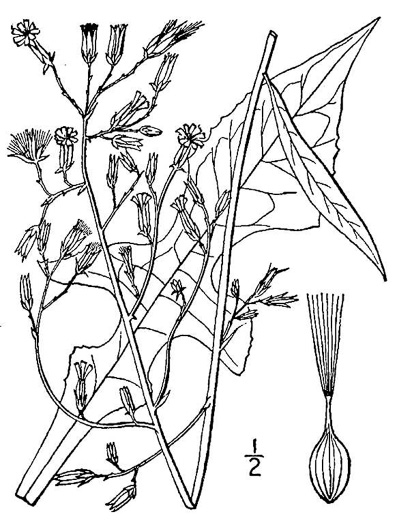
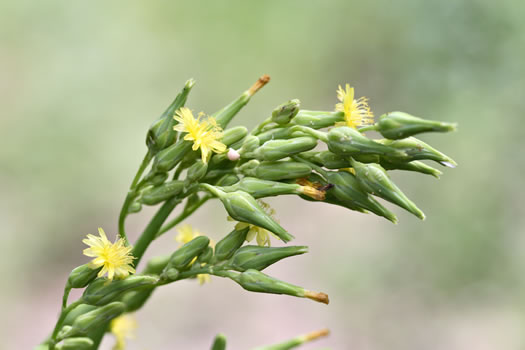
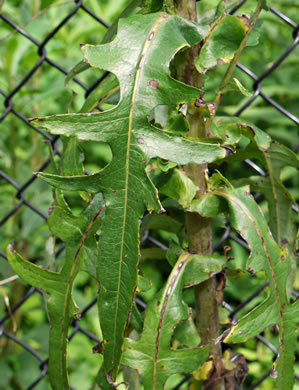
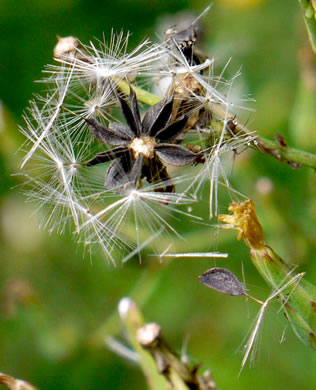
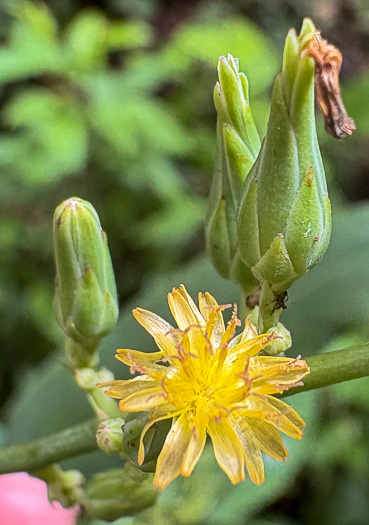
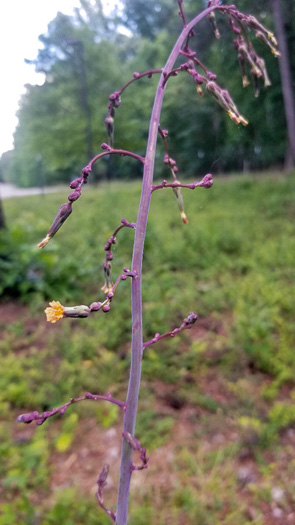
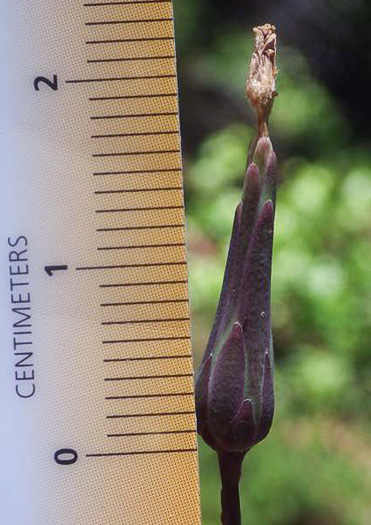
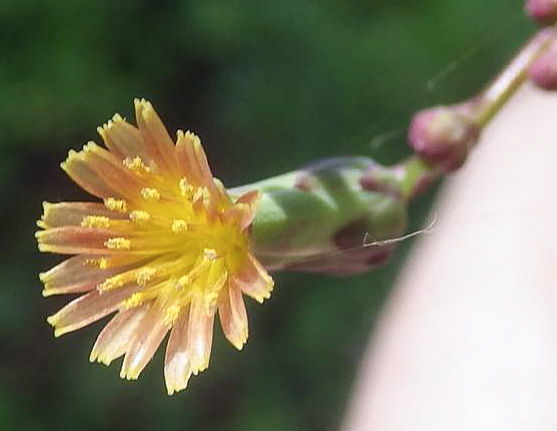
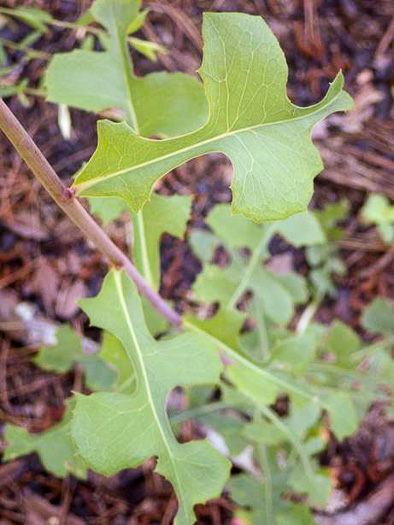
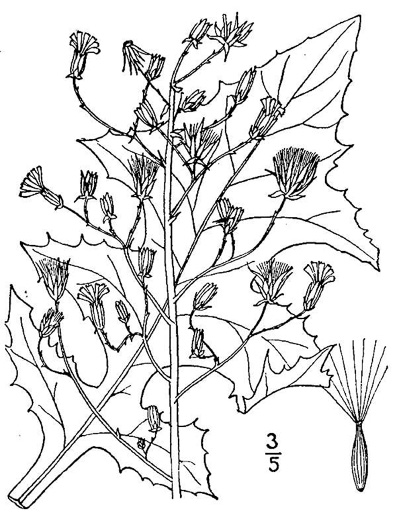
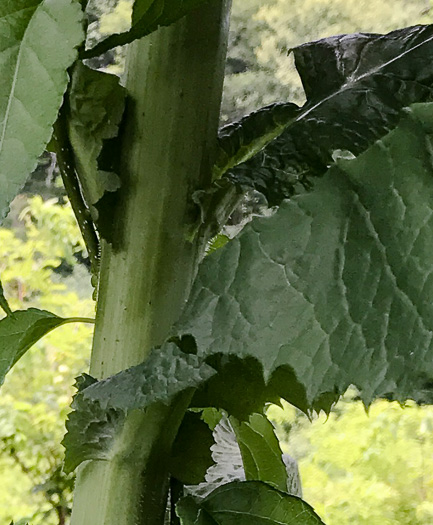
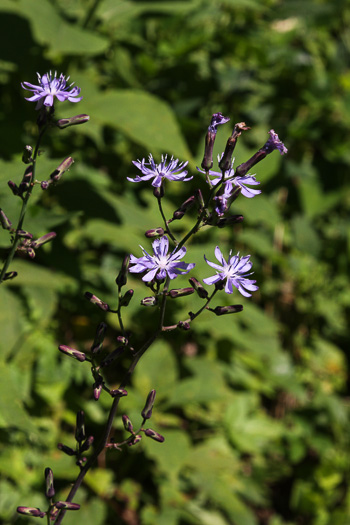
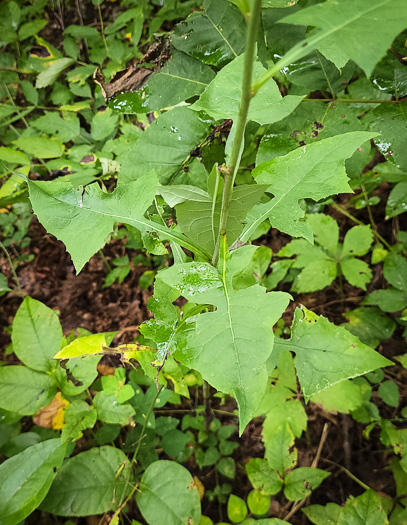
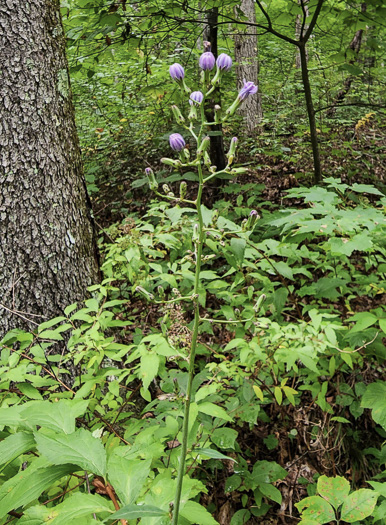
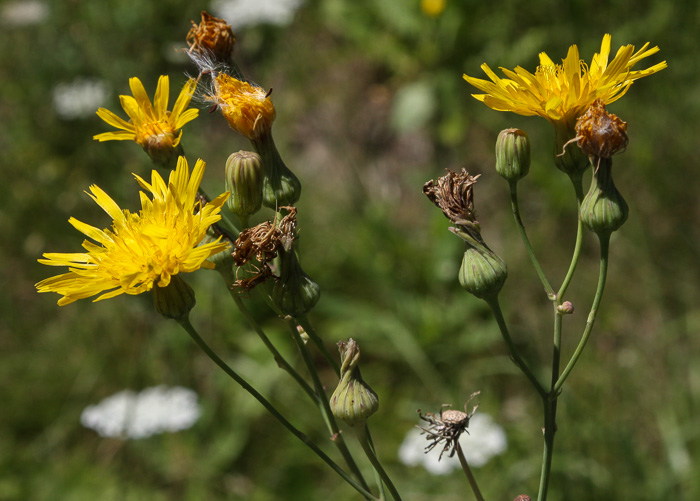

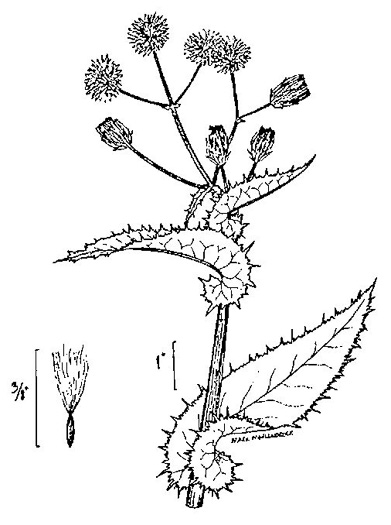
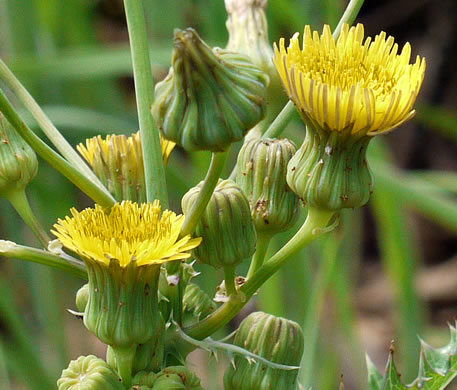
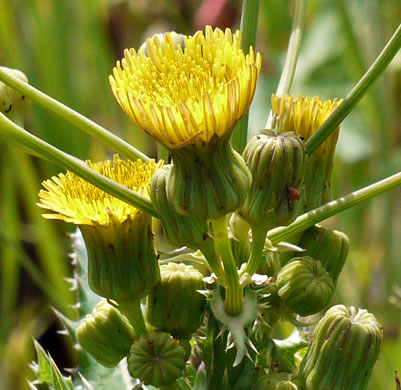
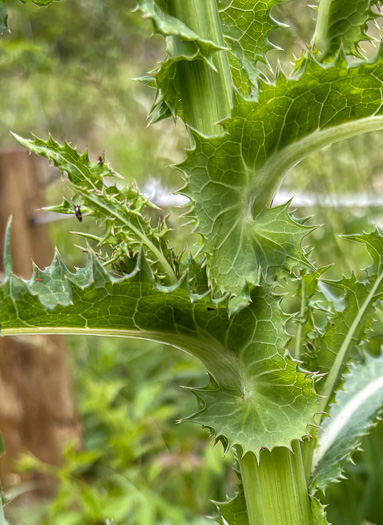
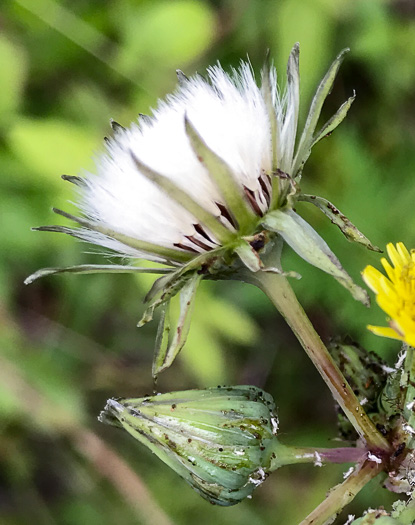
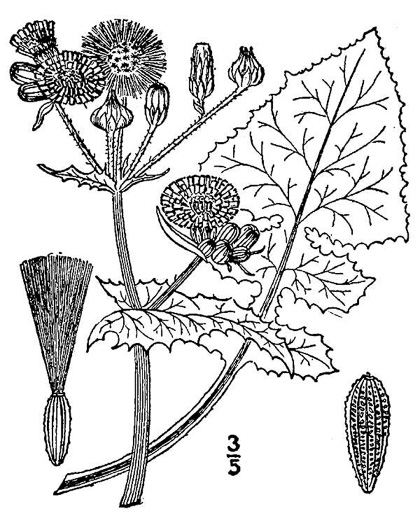
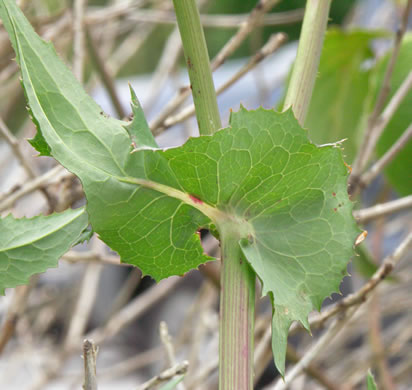
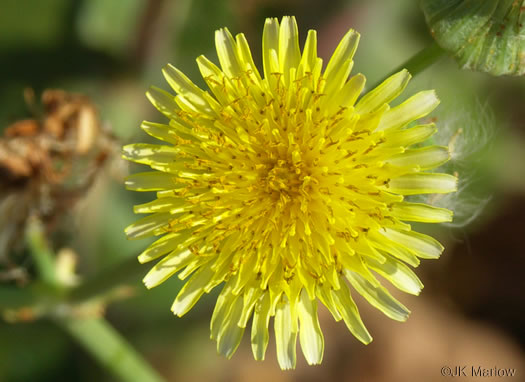
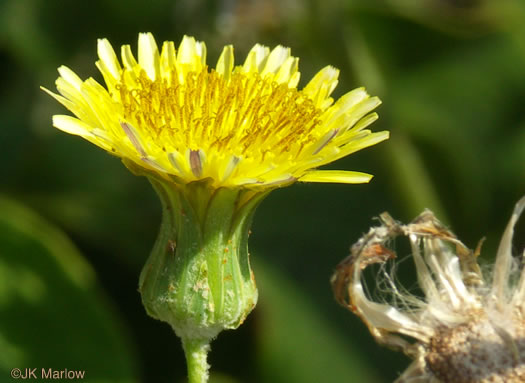
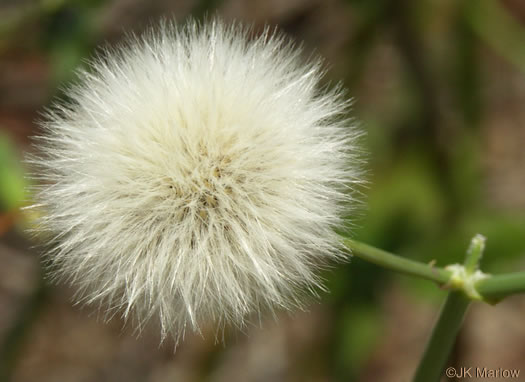
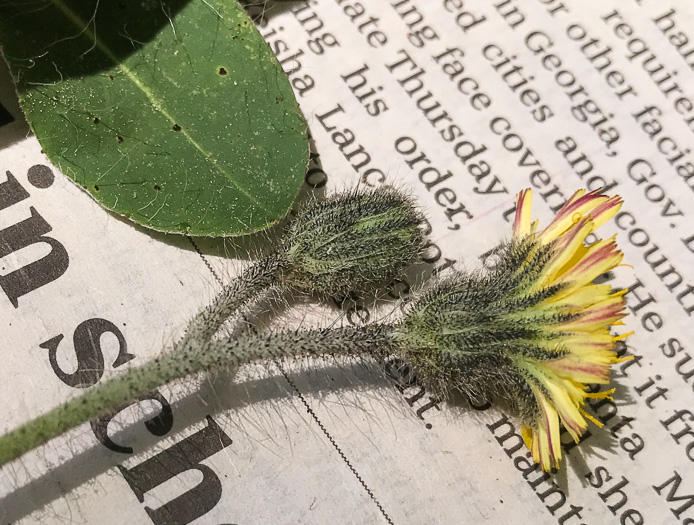
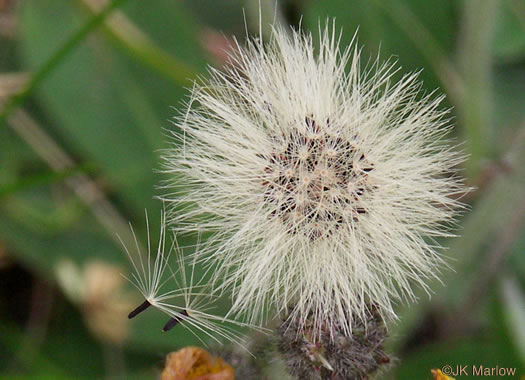
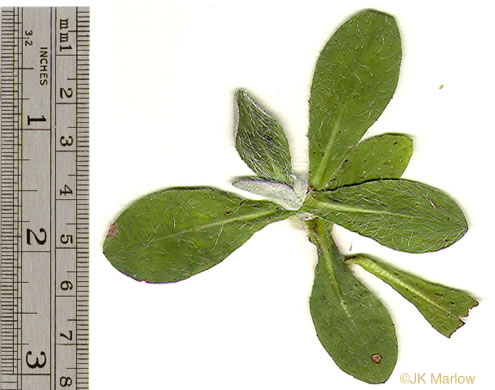
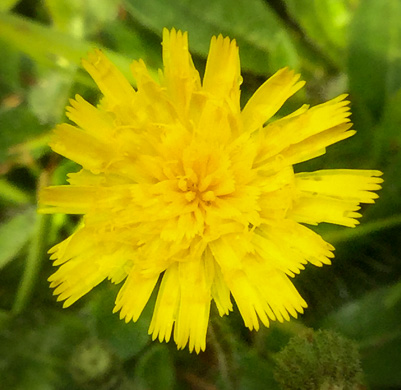
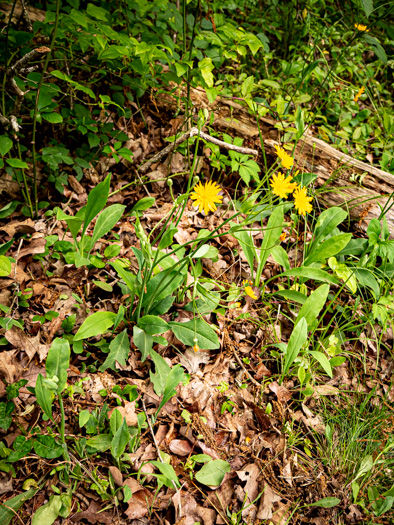
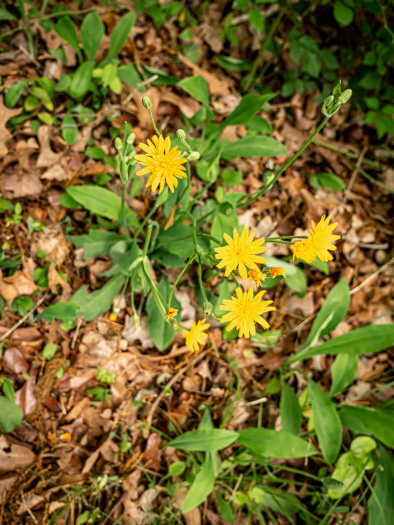
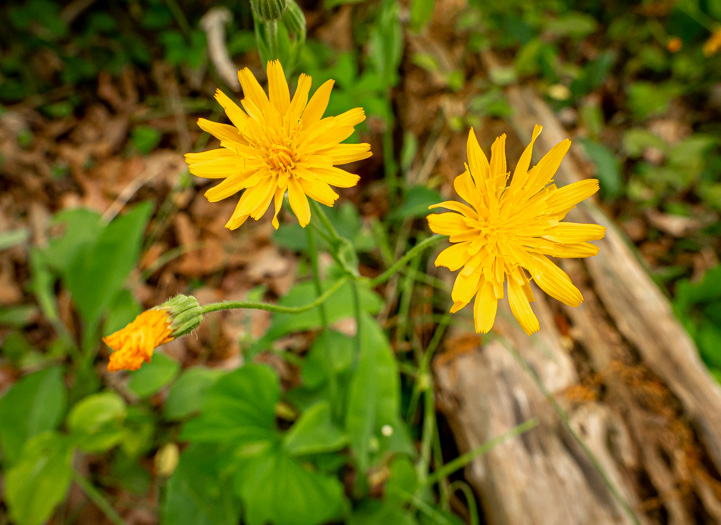
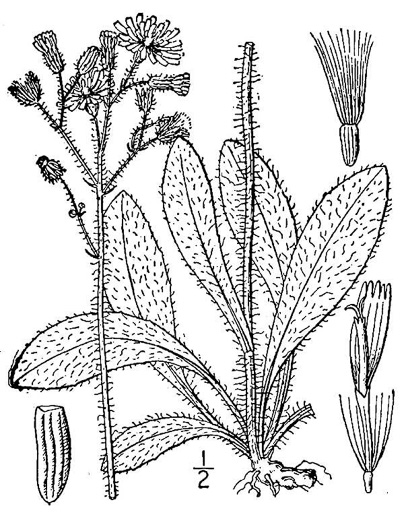
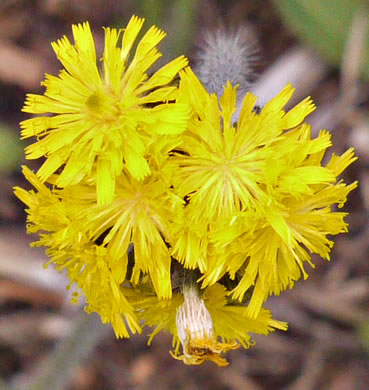
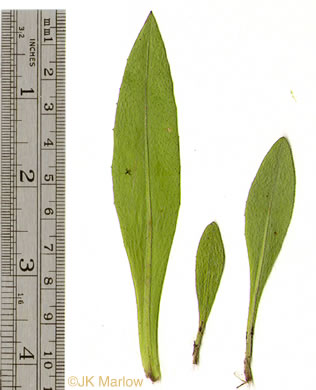
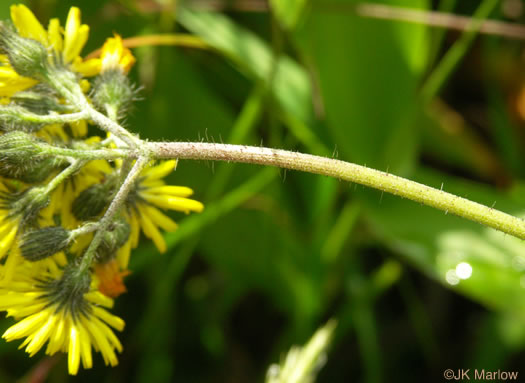
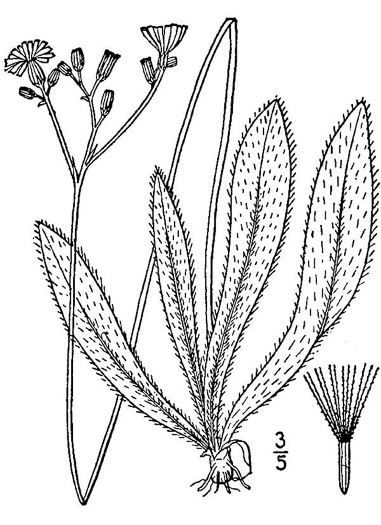
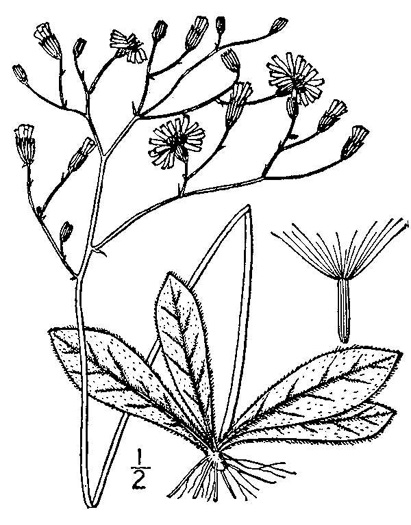
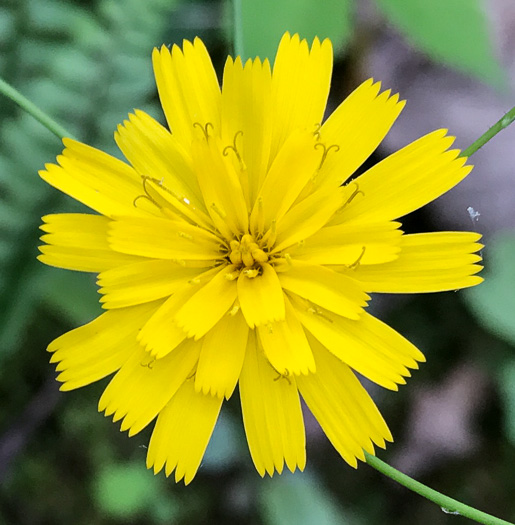
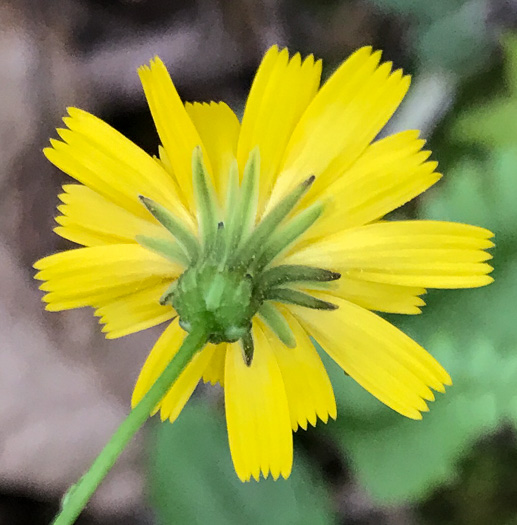
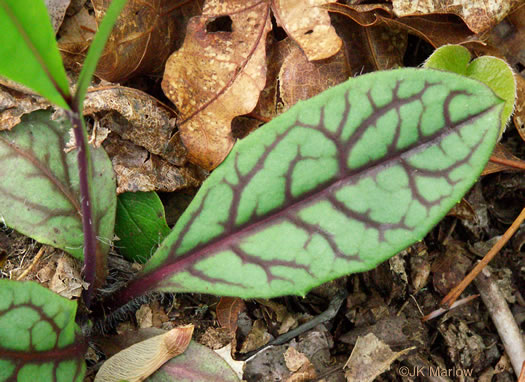
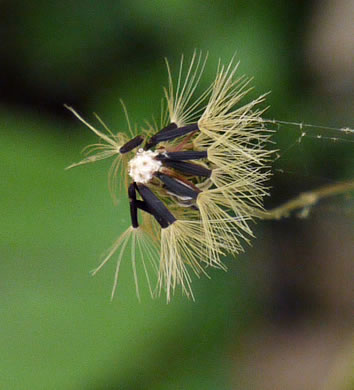
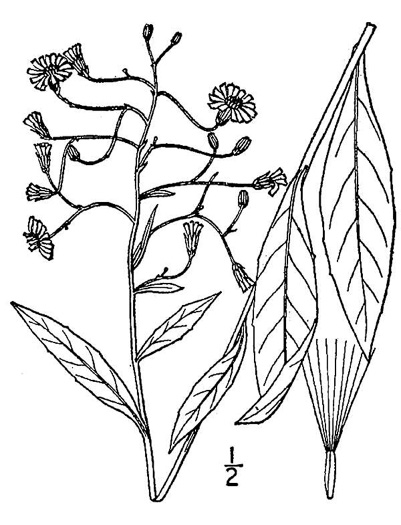
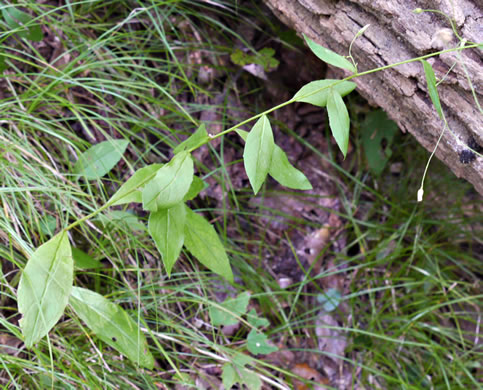
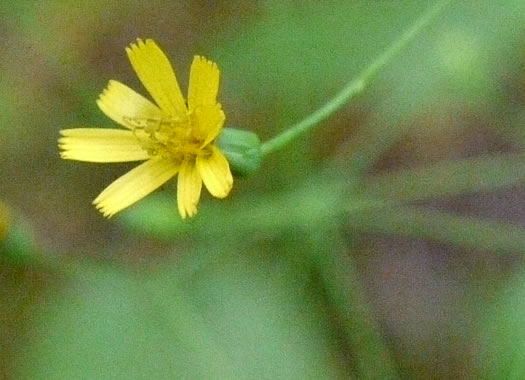
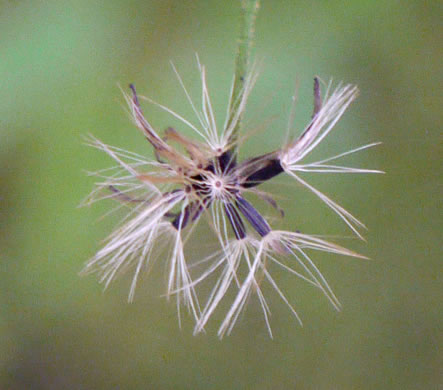
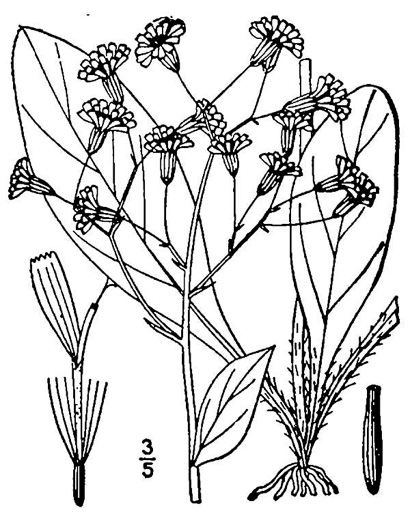
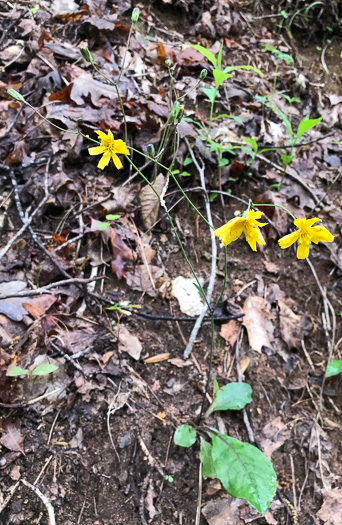
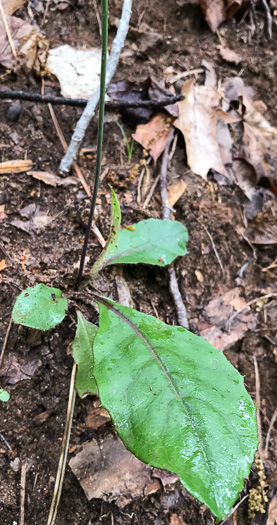
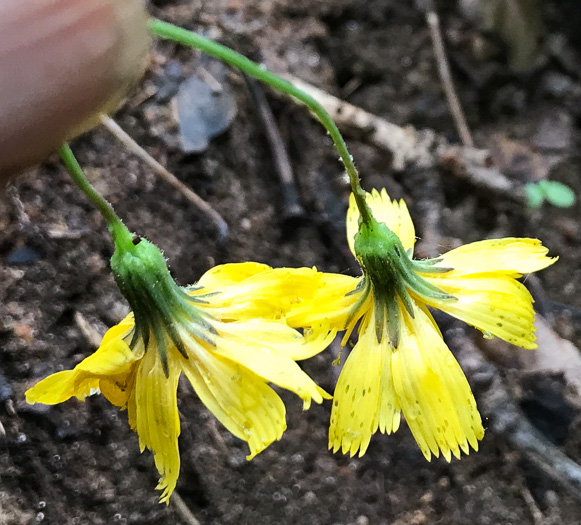
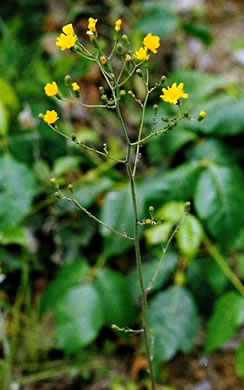
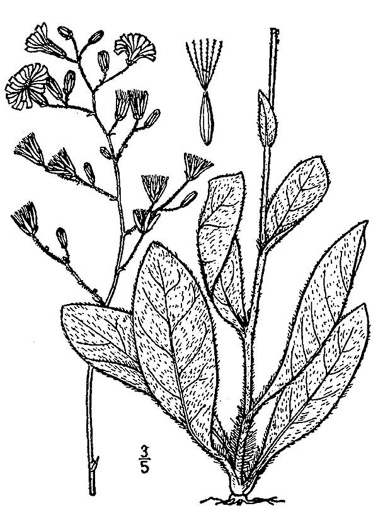
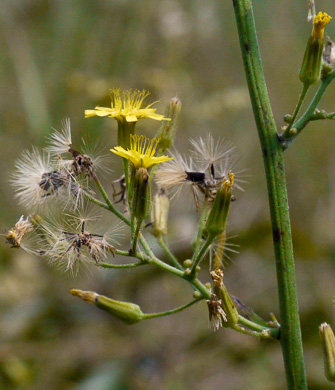
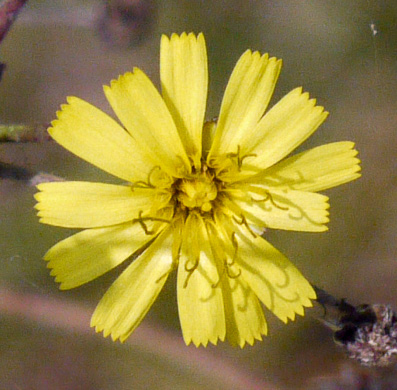
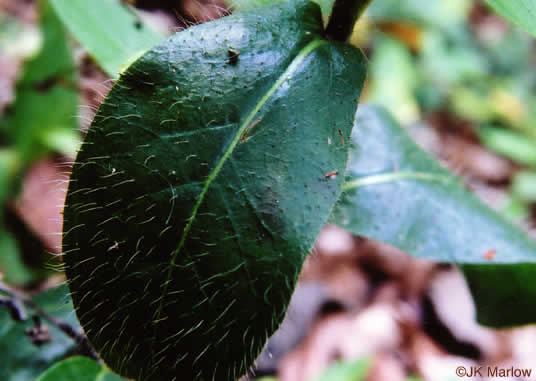
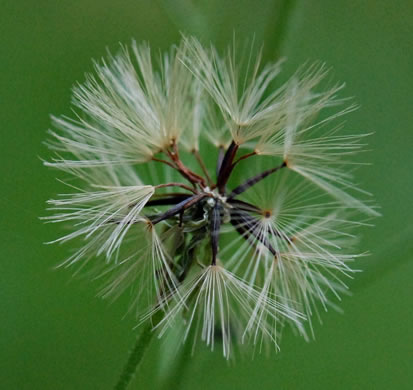
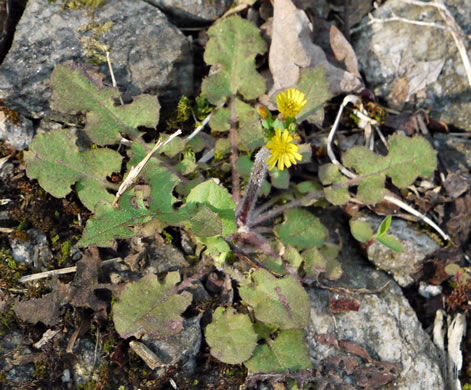
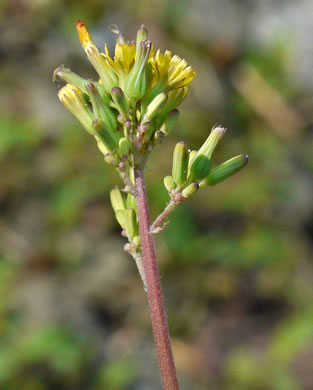
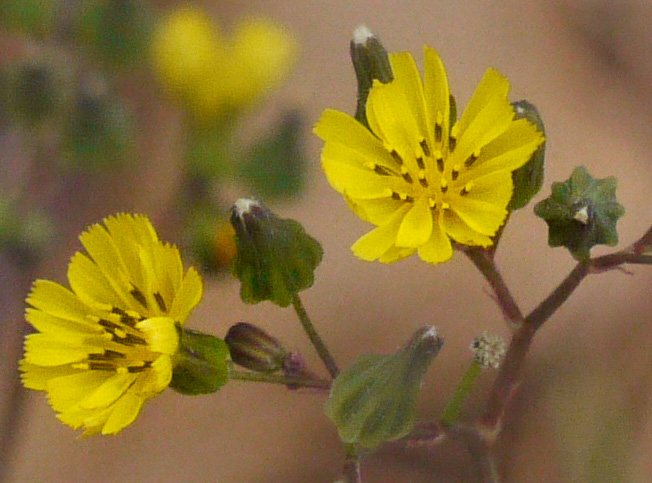
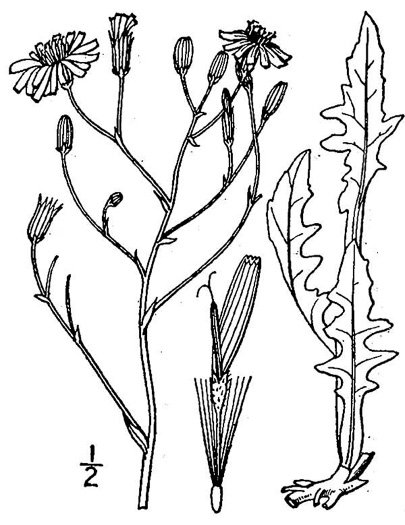
 Habitat: Pastures, roadsides, disturbed areas
Habitat: Pastures, roadsides, disturbed areas